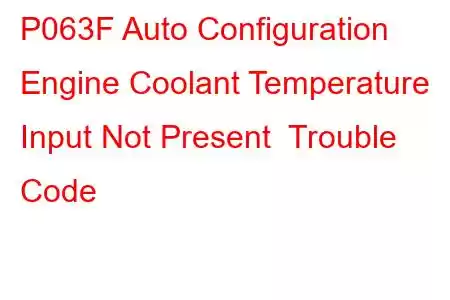P063F Auto Configuration Engine Coolant Temperature Input Not Present
OBD-II Trouble Code Technical Description
Auto Configuration Engine Coolant Temperature Input Not Present
What does that mean?
This is a generic diagnostic trouble code (DTC) and applies to many OBD-II vehicles (1996-newer). That may include but is not limited to vehicles from Nissan, Toyota, Mazda, Hyundai, Kia, etc. Although generic, the exact repair steps may vary depending on year, make, model and powertrain configuration.
If your OBD-II equipped vehicle has stored a code P063F, it means that the powertrain control module (PCM) has not detected an auto configuration engine coolant temperature input signal.
When the ignition cylinder is placed in the ON position and the various on-board controllers (the PCM included) are energized, multiple self-tests are initiated. The PCM depends upon input signals from engine sensors to automatically configure an engine start-up strategy and perform these self-tests. Engine coolant temperature is among the key input signals required by the PCM for auto configuration.
The engine coolant temperature sensor (ECT) should provide the PCM (and other controllers) with a engine coolant temperature input signal for automatic configuration purposes. The ECT is a brass, steel or plastic sensor with a thermal resistor (suspended in resin) inside the tip. The ECT is typically threaded into an engine coolant passage so that the tip is inserted into the passage. Engine coolant flows across the tip of the sensor and affects the thermal resistor inside. As engine coolant warms up, ECT sensor resistance decreases and circuit voltage increases. As engine coolant temperature decreases, ECT sensor resistance decreases and circuit voltage decreases.
If the PCM fails to detect a ECT sensor input circuit, when the ignition switch is placed in the ON position and the PCM is energized, a code P063F will be stored and a malfunction indicator lamp may be illuminated. The auto configuration system may also be deactivated; resulting in serious drivability issues.
A typical coolant temperature sensor:
What is the severity of this DTC?
Auto configuration codes should be taken seriously as engine start up idle quality and drivability may be at risk. Classify a stored code P063F as severe and address it as such.
What are some of the symptoms of the code?
Symptoms of a P063F trouble code may include:
Engine stall at idle (especially at start up) Delayed engine start Drivability issues Other ECT related codesWhat are some of the common causes of the code?
Causes for this code may include:
Defective ECT Open or shorted circuit between the ECT and PCM Corrosion in ECT connector Bad PCM or PCM programming errorWhat are some P063F troubleshooting steps?
If there are other ECT related codes present, diagnose and repair those before attempting to diagnose the P063F. Also make sure that the engine is full of the appropriate coolant and not overheating before testing.
A diagnostic scanner, a digital volt/ohmmeter (DVOM), an infrared thermometer with a laser pointer, and a reliable source of vehicle information will be required to accurately diagnose a code P063F.
Consult your source of vehicle information for applicable technical service bulletins (TSB). If you discover one that matches the vehicle, symptoms, and codes with which you are wrestling, it may aid in reaching a correct diagnosis.
I always begin any code diagnosis by connecting the scanner to the vehicle diagnostic port and retrieving all stored codes and pertinent freeze frame data. I like to write this information down (or print it if possible) in case I need it later (after the codes are cleared). Next, I clear the codes and test drive the vehicle until one of two scenarios occurs:
A. The code fails to reset and
Read: 44


